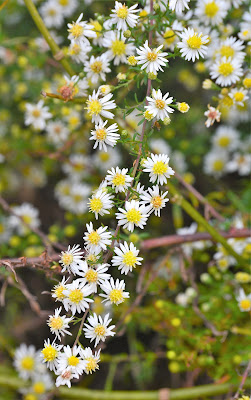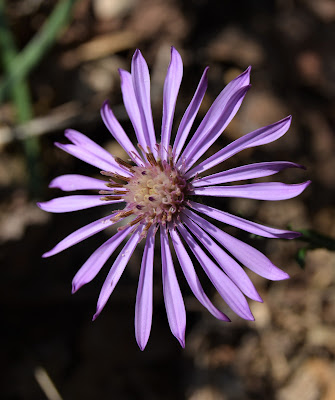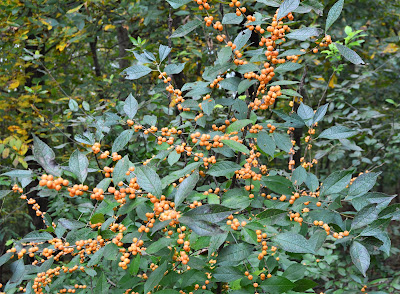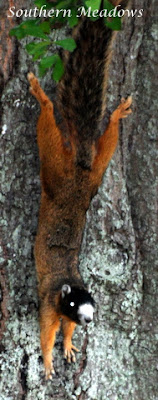It's Bloom Day, an opportunity to share with you a mini tour of our garden in autumn color. Be sure to visit May Dreams Gardens for more fall inspiration from gardens around the globe.
October is one of my favorite months of the year. It finally feels like fall in our Zone 8a/7b garden. The light in the garden is soothing and gently and the plants in the landscape standout with some of my favorite colors.
The Whites & Yellows
The heath aster (Symphyotrichum ericoides) is a popular place for bees, wasps and pollinating flies. The tightly packed flowers make it easy for pollinators to walk along the stalk of the plant collecting pollen and nectar as they go. The dainty blooms pair with ageratum in our wildlife hedgerow.
Swamp sunflower or narrow leaf sunflower (Helianthus angustifolius) is a favorite of bees and later will provide goldfinches with seeds. Mid-summer, I prune the plants at the edges of the flower beds so they don't grow too tall and flop over into the pathways later in the season. This practice also makes it easier to photograph the flowers and all the bees that visit.
Maryland goldenaster (
Chrysopsis mariana) is a beauty that is often seen growing along the roadside in Northeast Georgia. It makes a great perennial boarder plant or addition to a wildflower meadow.
The Blues and Purples
Hardy Ageratum is a butterfly favorite. Skippers, gulf fritillaries, cloudless sulphurs and migrating monarchs are often found visiting the fuzzy flowers.
One of our later blooming aster, the Georgia aster (Symphyotrichum georgianum), blooms from October through November. This iconic prairie wildflower grows at our wood's edge, where it receives bright light. Over the years it has reseeded, a happy situation for a rare plant.
Aromatic aster (
Symphyotrichum oblongifolium) is also just getting started. This is a native and honey bee favorite. On a sunny fall day the buzzing is boisterous.
The berries on American beautyberry (Callicarpa americana) are a bold statement in the landscape. Here it makes a lovely pairing with heath aster that reseeded nearby. The birds are already frequent visitors gobbling the berries. Soon the leaves will drop making the deep purple fruit standout even more.
It wouldn't feel like fall without the lovely purple plumes of muhly grass (
Muhlenbergia capilaris). In my opinion it is one of the most lovely native grasses for the landscape.
The Oranges & Reds
Red chokeberry (Aronia arbutifolia) is a wonderful shrub that grows in a vase shape with a slow suckering habit. It is deer resistant and provides a food source for birds and other mammals. The berries persist during the winter providing excellent color in the landscape.
Our calamondin tree is loaded with fruit this year. We grow this, along with several other citrus fruits, in containers that will be moved indoors before our first frost. Calamondin adds a nice citrus zing to desserts and drinks.
We encourage Virginia creeper (
Parthenocissus quinquefolia) to grow up trees in the woodland garden. In drought years the leaves drop early, but this year we are seeing some nice foliage color.
The seeds of the bottlebrush buckeye (
Aesculus parviflora) have fabulous color and a wonderfully smooth texture. Put one in your pocket for good luck. I try to harvested several seeds each year to plant in containers that will eventually be transplanted in our garden. I must collect them quickly after dropping because they are popular with the squirrels.
More fruit and color is provided by the winterberry hollies (
Ilex verticulata). These wonderful foundation shrubs have prolific fruit set. 'Winter Red' grows in a front garden bed with Ryan's mum (
Chrysanthemum x morifolium) a local nursery [Goodness Grows] introduction by Ryan Gainey.
'Winter Gold' has fabulous orange berries which are a favorite of our bluebirds. These native hollies need a male shrub such as 'Southern Gentleman'. Landscape tip: plant the male behind the females since he won't bear fruit and the showy females will be front and center.
Is your garden showing its fall color? Share your favorites in comments.
See more fall photos from our garden on
Instagram
















.png)
